-
About
- About Listly
- Community & Support
- Howto
- Chrome Extension
- Bookmarklet
- WordPress Plugin
- Listly Premium
- Privacy
- Terms
- DMCA Copyright
- © 2010-2025 Boomy Labs

 Rhonda Lesperance
Rhonda Lesperance
Listly by Rhonda Lesperance
Books for this summer reading list have outstanding appeal, meaning they were recently published or award winning, are a must-read for the college-bound, or show literary merit. Get caught reading books this summer and don't forget to read 200 pages each week!
Click on the books' tag (blue icon under the 'Views' tab), to find the reading level or interest that grabs you.
Source: http://www.nysl.nysed.gov/libdev/summer/brief01.pdf

Alice Sebold
When we first meet 14-year-old Susie Salmon, she is already in heaven. This was before milk carton photos and public service announcements, she tells us; back in 1973, when Susie mysteriously disappeared, people still believed these things didn't happen. In the sweet, untroubled voice of a precocious teenage girl, Susie relates the awful events of her death and her own adjustment to the strange new place she finds herself. It looks a lot like her school playground, with the good kind of swing sets. With love, longing, and a growing understanding, Susie watches her family as they cope with their grief, her father embarks on a search for the killer, her sister undertakes a feat of amazing daring, her little brother builds a fort in her honor and begin the difficult process of healing. In the hands of a brilliant novelist, this story of seemingly unbearable tragedy is transformed into a suspenseful and touching story about family, memory, love, heaven, and living.

Alex Flinn
A modern retelling of "Beauty and the Beast" from the point of view of the Beast, a vain Manhattan private school student who is turned into a monster and must find true love before he can return to his human form.

Jennifer Donnelly
Two girls, two centuries apart. One never knowing the other. But when Andi finds Alexandrine’s diary, she recognizes something in her words and is moved to the point of obsession. There’s comfort and distraction for Andi in the journal’s antique pages—until, on a midnight journey through the catacombs of Paris, Alexandrine’s words transcend paper and time, and the past becomes suddenly, terrifyingly present.

Foer, Jonathan Safran
In his first work of nonfiction, Foer (Everything Is Illuminated; Extremely Loud and Incredibly Close) turns his attention to the meat production industry. Like Jeffrey Moussaieff Masson in The Face on Your Plate: The Truth About Food, Foer exposes the role factory farming and aquaculture plays in global warming and environmental degradation but takes a less radical approach. Advocating for a vegetarian instead of a vegan diet and insisting that measures be taken to lessen the negative impacts of our current means for producing meat, Foer isn't demanding drastic dietary changes but rather asking readers to explore the origins of their eating habits. An on-again, off-again vegetarian, Foer is using his book not as a polemical soapbox but as a means to explore philosophical and ethical issues that have become more urgent to him in his new role as a father. Adding balance, he incorporates the opinions of an animal rights activist, an independent poultry farmer, a vegetarian rancher, and even a vegan who helps design slaughterhouses. Verdict This is sure to attract animal welfare and animal rights advocates as well as Foer's fans and general readers interested in learning more about the meat they eat.
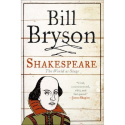
by Bill Bryson
At first glance, Bill Bryson seems an odd choice to write this addition to the Eminent Lives series.
The author of 'The Life and Times of the Thunderbolt Kid' isn't, after all, a Shakespeare scholar, a playwright, or even a biographer.
Reading 'Shakespeare The World As Stage', however, one gets the sense that this eclectic Iowan is exactly the type of person the Bard himself would have selected for the task.
The man who gave us 'The Mother Tongue' and 'A Walk in the Woods' approaches Shakespeare with the same freedom of spirit and curiosity that made those books such reader favorites. A refreshing take on an elusive literary master.
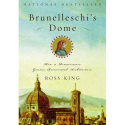
by Ross King
An Independent Bestseller By all accounts, Filippo Brunelleschi, goldsmith and clockmaker, was an unkempt, cantankerous, and suspicious man-even by the generous standards according to which artists were judged in fifteenth-century Florence. He also designed and erected a dome over the cathedral of Santa Maria del Fiore-a feat of architectural daring that we continue to marvel at today-thus securing himself a place among the most formidable geniuses of the Renaissance. At first denounced as a madman, Brunelleschi literally reinvented the field of architecture amid plagues, wars, and political feuds to raise seventy million pounds of metal, wood, and marble hundreds of feet in the air. Ross King's captivating narrative brings to life the personalities and intrigue surrounding the twenty-eight-year-long construction of the dome, opening a window onto Florentine life during one of history's most fascinating eras.
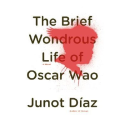
by Junot Diaz
Things have never been easy for Oscar, a sweet but disastrously overweight ghetto nerd, a Bew Jersey romantic who dreams of becoming the Dominican J.R.R. Tolkien and, most of all, of finding love. But he may never get what he wants, thanks to the fukú — the ancient curse that has haunted the Oscar's family for generations, dooming them to prison, torture, tragic accidents, and, above all, ill-starred love. Oscar, still dreaming of his first kiss, is only its most recent victim - until the fateful summer that he decides to be its last.
With dazzling energy and insight, Junot Díaz immerses us in the uproarious lives of our hero Oscar, his runaway sister Lola, and their ferocious beauty-queen mother Belicia, and in the epic journey from Santo Domingo to Washinton Heights to New Jersey's Bergenline and back again. Rendered with uncommon warmth and humor, The Brief Wondrous Life of Oscar Wao presents an astonishing vision of the comtemporary American experience and the endless human capacity to persevere - and to risk it all - in the of love.
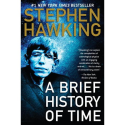
by Stephen Hawking
From the time of the ancient Greeks through the present time, this historical overview of cosmology is told by one of the most famous and fascinating scientists today.
In the ten years since its publication in 1988, Stephen Hawking's book has become a landmark volume in scientific writing, with more than nine million copies sold worldwide. That edition was on the cutting edge of what was then known about the nature of the universe. But the last decade has seen extraordinary advances in the technology of observing both the micro- and the macrocosmic worlds, confirming many of Professor Hawking's theoretical predictions. Eager to bring to his original text the new knowledge revealed by these observations, he has written a new introduction, updated the original chapters throughout, and added an entirely new chapter on the fascinating subject of wormholes and time travel.
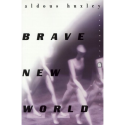
by Aldous Huxley
Far in the future, the World Controllers have finally created the ideal society. In laboratories worldwide, genetic science has brought the human race to perfection. From the Alpha-Plus mandarin class to the Epsilon-Minus Semi-Morons, designed to perform menial tasks, man is bred and educated to be blissfully content with his pre-destined role.
But, in the Central London Hatchery and Conditioning Centre, Bernard Marx is unhappy. Harbouring an unnatural desire for solitude, feeling only distaste for the endless pleasures of compulsory promiscuity, Bernard has an ill-defined longing to break free. A visit to one of the few remaining Savage Reservations where the old, imperfect life still continues, may be the cure for his distress…
A fantasy of the future that sheds a blazing critical light on the present--considered to be Aldous Huxley' s most enduring masterpiece.
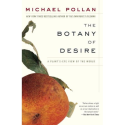
by Michael Pollan
Every schoolchild learns about the mutually beneficial dance of honeybees and flowers: The bee collects nectar and pollen to make honey and, in the process, spreads the flowers’ genes far and wide. In The Botany of Desire, Michael Pollan ingeniously demonstrates how people and domesticated plants have formed a similarly reciprocal relationship. He masterfully links four fundamental human desires—sweetness, beauty, intoxication, and control—with the plants that satisfy them: the apple, the tulip, marijuana, and the potato. In telling the stories of four familiar species, Pollan illustrates how the plants have evolved to satisfy humankind’s most basic yearnings. And just as we’ve benefited from these plants, we have also done well by them. So who is really domesticating whom?
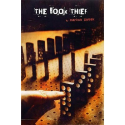
by Markus Zusak
Set during World War II in Germany, Markus Zusak’s groundbreaking novel is the story of Liesel Meminger, a foster girl living outside of Munich. Liesel scratches out a meager existence for herself by stealing when she encounters something she can’t resist–books. With the help of her accordion-playing foster father, she learns to read and shares her stolen books with her neighbors during bombing raids as well as with the Jewish man hidden in her basement before he is marched to Dachau.
The country is holding its breath. Death has never been busier, and will become busier still.
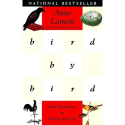
by Anne Lamott
"Thirty years ago my older brother, who was ten years old at the time, was trying to get a report on birds written that he'd had three months to write. [It] was due the next day. We were out at our family cabin in Bolinas, and he was at the kitchen table close to tears, surrounded by binder paper and pencils and unopened books on birds, immobilized by the hugeness of the task ahead. Then my father sat down beside him, put his arm around my brother's shoulder, and said. 'Bird by bird, buddy. Just take it bird by bird.'"
With this basic instruction always in mind, Anne Lamott returns to offer us a new gift: a step-by-step guide on how to write and on how to manage the writer's life. From "Getting Started,' with "Short Assignments," through "Shitty First Drafts," "Character," "Plot," "Dialogue." all the way from "False Starts" to "How Do You Know When You're Done?" Lamott encourages, instructs, and inspires. She discusses "Writers Block," "Writing Groups," and "Publication." Bracingly honest, she is also one of the funniest people alive.
If you have ever wondered what it takes to be a writer, what it means to be a writer, what the contents of your school lunches said about what your parents were really like, this book is for you. From faith, love, and grace to pain, jealousy, and fear, Lamott insists that you keep your eyes open, and then shows you how to survive. And always, from the life of the artist she turns to the art of life.
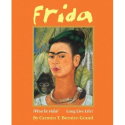
by Carmen T. Bernier-Grand
Frida Kahlo, a native of Mexico, is described here in biographical poems accompanied by her own artwork. Both text and images reveal the anguish and joy of her two marriages to muralist Diego Rivera, her life-long suffering from a crippling bus accident, and her thirst for life, even as she tasted death. Her favorite motto was: ¡Viva la vida! (Long live life!)
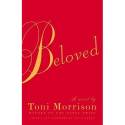
by Toni Morrison
Staring unflinchingly into the abyss of slavery, this spellbinding novel transforms history into a story as powerful as Exodus and as intimate as a lullaby. Sethe, its protagonist, was born a slave and escaped to Ohio, but eighteen years later she is still not free. She has too many memories of Sweet Home, the beautiful farm where so many hideous things happened. And Sethe's new home is haunted by the ghost of her baby, who died nameless and whose tombstone is engraved with a single word: Beloved. Filled with bitter poetry and suspense as taut as a rope, Beloved is a towering achievement by Nobel Prize laureate Toni Morrison.
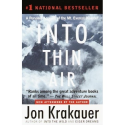
by Jon Krakauer
A bank of clouds was assembling on the not-so-distant horizon, but journalist-mountaineer Jon Krakauer, standing on the summit of Mt. Everest, saw nothing that "suggested that a murderous storm was bearing down." He was wrong. The storm, which claimed five lives and left countless more--including Krakauer's--in guilt-ridden disarray, would also provide the impetus for Into Thin Air, Krakauer's epic account of the May 1996 disaster.
By writing Into Thin Air, Krakauer may have hoped to exorcise some of his own demons and lay to rest some of the painful questions that still surround the event. He takes great pains to provide a balanced picture of the people and events he witnessed and gives due credit to the tireless and dedicated Sherpas. He also avoids blasting easy targets such as Sandy Pittman, the wealthy socialite who brought an espresso maker along on the expedition. Krakauer's highly personal inquiry into the catastrophe provides a great deal of insight into what went wrong. But for Krakauer himself, further interviews and investigations only lead him to the conclusion that his perceived failures were directly responsible for a fellow climber's death. Clearly, Krakauer remains haunted by the disaster, and although he relates a number of incidents in which he acted selflessly and even heroically, he seems unable to view those instances objectively. In the end, despite his evenhanded and even generous assessment of others' actions, he reserves a full measure of vitriol for himself.
This updated trade paperback edition of Into Thin Air includes an extensive new postscript that sheds fascinating light on the acrimonious debate that flared between Krakauer and Everest guide Anatoli Boukreev in the wake of the tragedy. "I have no doubt that Boukreev's intentions were good on summit day," writes Krakauer in the postscript, dated August 1999. "What disturbs me, though, was Boukreev's refusal to acknowledge the possibility that he made even a single poor decision. Never did he indicate that perhaps it wasn't the best choice to climb without gas or go down ahead of his clients." As usual, Krakauer supports his points with dogged research and a good dose of humility. But rather than continue the heated discourse that has raged since Into Thin Air's denouncement of guide Boukreev, Krakauer's tone is conciliatory; he points most of his criticism at G. Weston De Walt, who coauthored The Climb, Boukreev's version of events. And in a touching conclusion, Krakauer recounts his last conversation with the late Boukreev, in which the two weathered climbers agreed to disagree about certain points. Krakauer had great hopes to patch things up with Boukreev, but the Russian later died in an avalanche on another Himalayan peak, Annapurna I.
In 1999, Krakauer received an Academy Award in Literature from the American Academy of Arts and Letters--a prestigious prize intended "to honor writers of exceptional accomplishment." According to the Academy's citation, "Krakauer combines the tenacity and courage of the finest tradition of investigative journalism with the stylish subtlety and profound insight of the born writer. His account of an ascent of Mount Everest has led to a general reevaluation of climbing and of the commercialization of what was once a romantic, solitary sport; while his account of the life and death of Christopher McCandless, who died of starvation after challenging the Alaskan wilderness, delves even more deeply and disturbingly into the fascination of nature and the devastating effects of its lure on a young and curious mind."
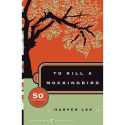
by Harper Lee
The unforgettable novel of a childhood in a sleepy Southern town and the crisis of conscience that rocked it. To Kill A Mockingbird became both an instant bestseller and a critical success when it was first published in 1960. It went on to win the Pulitzer Prize in 1961 and was later made into an Academy Award-winning film, also a classic.
Compassionate, dramatic, and deeply moving, To Kill A Mockingbird takes readers to the roots of human behavior—to innocence and experience, kindness and cruelty, love and hatred, humor and pathos. Now with over 18 million copies in print and translated into forty languages, this regional story, by a young Alabama woman, claims universal appeal. Harper Lee always considered her book to be a simple love story. Today it is regarded as a masterpiece of American literature.

by Carol Strickland, John Boswell
Be smart about art. The Annotated Mona Lisa takes art history out of the realm of dreary textbooks to a world of dynamic design, succinct page-length essays, and instructive sidebars.
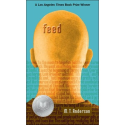
by M.T. Anderson
Identity crises, consumerism, and star-crossed teenage love in a futuristic society where people connect to the Internet via feeds implanted in their brains.
For Titus and his friends, it started out like any ordinary trip to the moon - a chance to party during spring break and play with some stupid low-grav at the Ricochet Lounge. But that was before the crazy hacker caused all their feeds to malfunction, sending them to the hospital to lie around with nothing inside their heads for days. And it was before Titus met Violet, a beautiful, brainy teenage girl who has decided to fight the feed and its omnipresent ability to categorize human thoughts and desires. Following in the footsteps of George Orwell, Anthony Burgess, and Kurt Vonnegut Jr., M. T. Anderson has created a not-so-brave new world — and a smart, savage satire that has captivated readers with its view of an imagined future that veers unnervingly close to the here and now.
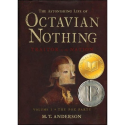
by M.T. Anderson
He is a boy dressed in silks and white wigs and given the finest of classical educations. Raised by a mysterious group of rational philosophers known only by numbers, the boy and his mother——a princess in exile from a faraway land——are the only people in their household assigned names. As the boy's regal mother, Cassiopeia, entertains the house scholars with her beauty and wit, young Octavian begins to question the purpose behind his guardians' fanatical studies. Only after he dares to open a forbidden door does he learn the hideous nature of their experiments——and his own chilling role in them. The first of two volumes, this deeply provocative novel reimagines the past as an eerie place with startling resonance for readers today.

by Julia Alvarez
Set during the waning days of the Trujillo dictatorship in the Dominican Republic in 1960, this extraordinary novel tells the story the Mirabal sisters, three young wives and mothers who are assassinated after visiting their jailed husbands.
From the author of How the Garcia Girls Lost Their Accents comes this tale of courage and sisterhood set in the Dominican Republic during the rise of the Trujillo dictatorship. A skillful blend of fact and fiction, In the Time of the Butterflies is inspired by the true story of the three Mirabal sisters who, in 1960, were murdered for their part in an underground plot to overthrow the government. Alvarez breathes life into these historical figures--known as "las mariposas," or "the butterflies," in the underground--as she imagines their teenage years, their gradual involvement with the revolution, and their terror as their dissentience is uncovered.
Alvarez's controlled writing perfectly captures the mounting tension as "the butterflies" near their horrific end. The novel begins with the recollections of Dede, the fourth and surviving sister, who fears abandoning her routines and her husband to join the movement. Alvarez also offers the perspectives of the other sisters: brave and outspoken Minerva, the family's political ringleader; pious Patria, who forsakes her faith to join her sisters after witnessing the atrocities of the tyranny; and the baby sister, sensitive Maria Teresa, who, in a series of diaries, chronicles her allegiance to Minerva and the physical and spiritual anguish of prison life.
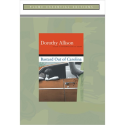
by Dorothy Allison
Greenville County, South Carolina, a wild, lush place, is home to the Boatwright family—rough-hewn men who drink hard and shoot up each other's trucks, and indomitable women who marry young and age all too quickly. At the heart of this astonishing novel is Ruth Anne Boatwright, known simply as Bone, a South Carolina bastard with an annotated birth certificate to tell the tale. Observing everything with the mercilessly keen eye of a child, Bone finds herself caught in a family triangle that will test the loyalty of her mother, Anney. Her stepfather, Daddy Glen, calls Bone "cold as death, mean as a snake, and twice as twisty," yet Anney needs Glen. At first gentle with Bone, Daddy Glen becomes steadily colder and more furious—until their final, harrowing encounter, from which there can be no turning back.
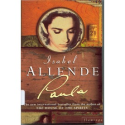
by Isabelle Allende
This book started as a letter to Paula written during the hours spent at her bedside, and became a personal memoir and a testament to the ties that bind families - a brave, enlightening, inspiring true story.
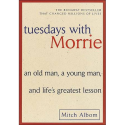
by Mitch Albom
Nearly 20 years after their first lessons, now dying college professor Morrie imparts his wisdom to student Mitch during weekly Tuesday meetings. A gentle mentor imparts the lessons of a long life.
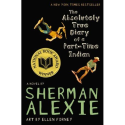
by Sherman Alexie
In his first book for young adults, bestselling author Sherman Alexie tells the story of Junior, a budding cartoonist growing up on the Spokane Indian Reservation. Determined to take his future into his own hands, Junior leaves his troubled school on the rez to attend an all-white farm town high school where the only other Indian is the school mascot. Heartbreaking, funny, and beautifully written, The Absolutely True Diary of a Part-Time Indian, which is based on the author's own experiences, coupled with poignant drawings by acclaimed artist Ellen Forney, that reflect the character's art, chronicles the contemporary adolescence of one Native American boy as he attempts to break away from the life he was destined to live.
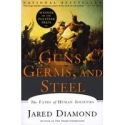
by Jared Diamond
Life isn't fair--here's why: Since 1500, Europeans have, for better & worse, called the tune that the world has danced to. In Guns, Germs & Steel, Jared Diamond explains the reasons why things worked out that way. It's an elemental question. Diamond is certainly not the 1st to ask it. However, he performs a singular service by relying on scientific fact rather than specious theories of European genetic superiority. Diamond, a UCLA physiologist, suggests that the geography of Eurasia was best suited to farming, the domestication of animals & the free flow of information. The more populous cultures that developed as a result had more complex forms of government & communication, & increased resistance to disease. Finally, fragmented Europe harnessed the power of competitive innovation in ways that China didn't. (For example, the Europeans used the Chinese invention of gunpowder to create guns & subjugate the New World.) Diamond's book is complex & a bit overwhelming. But the thesis he methodically puts forth--examining the "positive feedback loop" of farming, then domestication, then population density, then innovation etc.--makes sense. Written without bias, Guns, Germs & Steel is good global history.
